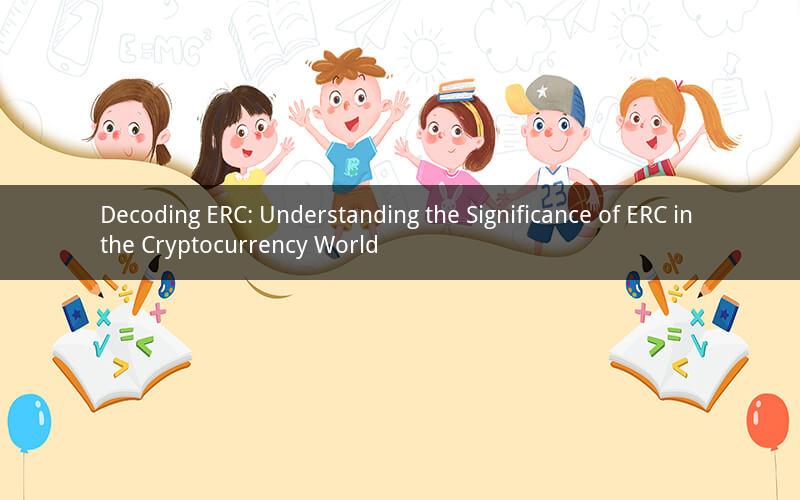
In the vast landscape of cryptocurrency, the term ERC stands for Ethereum Request for Comments. It is a crucial component that has shaped the development and growth of various decentralized applications and smart contracts. This article delves into the meaning of ERC, its importance, and the diverse applications of different ERC standards in the crypto industry.
1. What is ERC?
ERC, or Ethereum Request for Comments, is a set of technical specifications that define standards for smart contracts and decentralized applications on the Ethereum blockchain. These specifications are proposed and reviewed by the Ethereum community, ensuring that the standards are open, transparent, and widely accepted.
2. The Importance of ERC in Cryptocurrency
ERC has played a vital role in the crypto industry by providing a standardized framework for smart contracts and decentralized applications. Here are some key reasons why ERC is important:
a. Interoperability: ERC standards ensure that different applications and smart contracts can interact seamlessly with each other, allowing developers to build complex and diverse ecosystems.
b. Security: By following ERC standards, developers can create more secure and reliable smart contracts, reducing the risk of vulnerabilities and fraud.
c. Scalability: ERC standards help improve the scalability of Ethereum, making it more efficient and cost-effective for developers to deploy and run their applications.
d. Adoption: The widespread adoption of ERC standards has contributed to the growth of the Ethereum ecosystem, attracting more developers and users to the platform.
3. Different ERC Standards
There are several ERC standards, each serving a specific purpose in the crypto industry. Here are some of the most notable ERC standards:
a. ERC-20: The most popular ERC standard, ERC-20, defines a set of rules for fungible tokens on the Ethereum blockchain. It ensures that different tokens are interchangeable and can be easily transferred between users.
b. ERC-721: ERC-721 is a standard for non-fungible tokens (NFTs), which are unique digital assets that cannot be exchanged on a one-to-one basis. This standard has gained significant traction in the art, gaming, and collectibles sectors.
c. ERC-1155: ERC-1155 is an upgraded version of ERC-20 and ERC-721, allowing developers to create both fungible and non-fungible tokens within a single smart contract. This standard aims to improve the efficiency and scalability of token-based applications.
d. ERC-223: ERC-223 is a standard for fungible tokens that introduces a new transfer function, enabling tokens to be transferred directly to a contract, making it more secure and efficient than ERC-20.
e. ERC-2612: ERC-2612 is a standard for upgrading smart contracts, allowing developers to modify and improve their contracts without deploying a new contract and losing the existing balances.
4. The Impact of ERC on the Crypto Industry
The introduction of ERC standards has had a profound impact on the crypto industry, transforming the way developers and users interact with blockchain technology. Here are some notable impacts:
a. Growth of the Ethereum ecosystem: ERC standards have facilitated the growth of the Ethereum ecosystem, attracting developers, investors, and users from around the world.
b. Increased adoption of smart contracts: ERC standards have made it easier for developers to create and deploy smart contracts, leading to a surge in decentralized applications (dApps) on the Ethereum network.
c. Advancements in tokenization: ERC standards have enabled the tokenization of various assets, including real estate, stocks, and commodities, making it easier for users to access and trade these assets.
5. Future of ERC in Cryptocurrency
The future of ERC in the crypto industry looks promising, with ongoing developments and improvements. Here are some potential future developments:
a. Enhanced security: As the crypto industry continues to evolve, there is a growing emphasis on improving the security of smart contracts and decentralized applications. Future ERC standards may focus on addressing vulnerabilities and enhancing the overall security of the Ethereum ecosystem.
b. Increased scalability: Scalability remains a crucial challenge for the Ethereum network. Future ERC standards may explore innovative solutions to improve the network's capacity and reduce transaction fees.
c. Cross-chain interoperability: The integration of ERC standards with other blockchains will enable cross-chain interoperability, allowing users to interact with different blockchain platforms seamlessly.
In conclusion, ERC has become an integral part of the cryptocurrency industry, providing a standardized framework for smart contracts and decentralized applications. As the industry continues to grow, ERC standards will likely play a crucial role in shaping the future of blockchain technology.
Questions and Answers:
1. Q: What is the main purpose of ERC standards?
A: The main purpose of ERC standards is to define a set of technical specifications for smart contracts and decentralized applications on the Ethereum blockchain, ensuring interoperability, security, scalability, and widespread adoption.
2. Q: How does ERC-20 differ from ERC-721?
A: ERC-20 is a standard for fungible tokens, which are interchangeable and can be transferred on a one-to-one basis. ERC-721, on the other hand, is a standard for non-fungible tokens, which are unique and cannot be exchanged on a one-to-one basis.
3. Q: Can ERC-1155 tokens be used for both fungible and non-fungible assets?
A: Yes, ERC-1155 tokens can be used for both fungible and non-fungible assets, allowing developers to create more efficient and scalable token-based applications.
4. Q: What is the main advantage of ERC-223 over ERC-20?
A: The main advantage of ERC-223 over ERC-20 is that it introduces a new transfer function, enabling tokens to be transferred directly to a contract, making it more secure and efficient.
5. Q: How will ERC standards evolve in the future?
A: Future ERC standards are likely to focus on enhancing security, improving scalability, and promoting cross-chain interoperability, ensuring that the Ethereum ecosystem remains competitive and innovative in the rapidly evolving crypto industry.